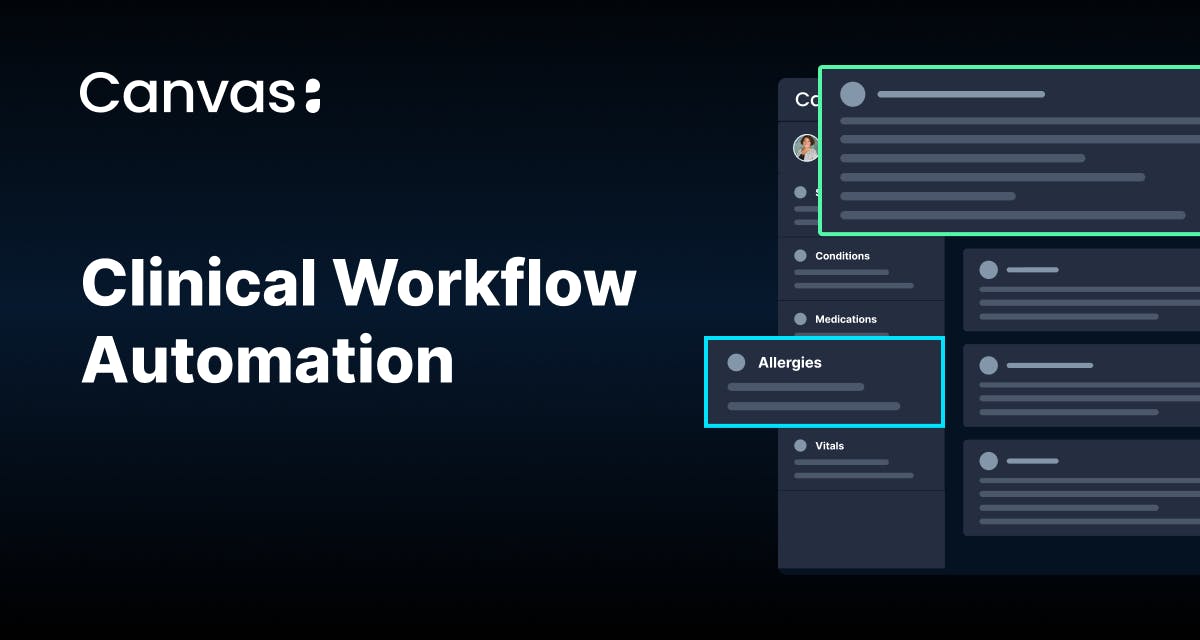Every minute a physician spends clicking through an EMR, hunting for prior auth forms, or waiting for data to sync is a minute stolen from patient care. The average primary care physician spends two hours on administrative tasks for every hour of direct patient interaction. This isn't sustainable—and it's precisely why clinical workflow automation is an existential necessity for a high performing outpatient care organization.
But here's what won’t work: treating automation as a feature you bolt onto legacy systems. Effective workflow automation isn't about digitizing broken processes or adding an RPA layer on top of a closed architecture software system. It's about leveraging modern, programmable infrastructure that can improve everyday medicine.
Clinical workflow automation can handle repetitive clinical and administrative tasks, freeing healthcare teams to focus on diagnosis, treatment, and human connection. When done right, it doesn't just make healthcare faster. It makes it safer, more personal, and economically efficient.
What Is Clinical Workflow Automation?
Clinical workflow automation uses deterministic and agentic tools and APIs to streamline healthcare processes. In traditional care delivery settings staff constantly data between systems, make phone calls, or track down missing clinical information. All of that can be down with automation to connect these steps into intelligent workflows.
There are many use cases for clinical workflow automation. At Canvas, our team, our customers and our partners have built thousands of automated workflows using the Canvas SDK. A few highlighted use cases that clinical workflow automation can streamline:
- Pull patient intake data directly into structured EMR fields without transcription
- Schedule appointments based on provider availability, patient preference, and clinical urgency
- Verify insurance eligibility in real-time, surfacing copays and coverage details at check-in
- Route abnormal lab results to the right clinician with contextual patient history
- Generate prior authorization requests with supporting documentation pre-populated
- Trigger follow-up tasks based on clinical events—no manual tracking needed
When surfaced correctly at the point of care, clinical workflow automation can prevent the biggest source of healthcare errors: manual handoffs between disconnected systems. When data flows programmatically, it arrives complete, accurate, and on time.
Why Most Healthcare Automation Fails
The failure mode in healthcare has been legacy EMR vendors bolting on "automation" modules within rigid architectures and user interfaces. This reinforces data silo’s and solidifies inefficient processes and workarounds.
The core problem is architecture. Traditional EMRs were built as monolithic applications—closed systems designed for a narrow set of workflows. When you try to automate processes across these systems, you're stuck with:
- Brittle integrations that break when vendors update their systems
- Limited customization that forces care teams into vendor-defined workflows
- Manual workarounds that defeat the purpose of automation
- Vendor lock-in that prevents innovation
Real workflow automation requires a different foundation: programmable infrastructure that healthcare organizations can extend, customize, and control.
The Programmable Approach to Workflow Automation
Healthcare delivery is too complex and variable for one-size-fits-all solutions. A pediatric practice, addiction medicine clinic, and multi-specialty health system face fundamentally different workflow challenges. Effective automation must adapt to these differences—not force every organization into the same rigid mold.
This is why the most sophisticated healthcare organizations are moving toward programmable platforms that can offer:
- SDK-First Architecture - Instead of configuring limited options in a vendor dashboard, care teams can build custom workflows using modern development tools. Need to integrate a specialty-specific screening tool? Build it. Want to automate prior auth for your payer mix? Code it. Require specialized reporting for your value-based contracts? Program it.
- FHIR-Native Data Models - Automation breaks when systems can't communicate. FHIR (Fast Healthcare Interoperability Resources) provides standardized data models that enable true interoperability. When your EMR is FHIR-native, data flows between systems without custom mappings or brittle point-to-point integrations.
- Event-Driven Workflows - Effective automation responds to clinical events in real-time. When a lab result arrives, the system doesn't wait for someone to check a queue—it immediately evaluates the data, determines clinical significance, and triggers appropriate actions. High blood pressure reading? Alert the care team and schedule a follow-up. Normal results? File automatically and update the patient portal.
- AI Agents as Workflow Participants - The next evolution in automation isn't just rules engines—it's AI agents that can handle complex, contextual tasks. Rather than programming every possible scenario, organizations deploy agents that understand clinical context and can take appropriate action. These agents don't replace clinicians; they amplify their capabilities by handling time-consuming tasks like documentation, care plan adjustments, and patient education.
How Canvas Medical Enables Programmable Workflow Automation
Canvas Medical was built from the ground up to solve the core problem healthcare faces: inflexible software that can't adapt to how medicine actually works. Rather than bolt automation onto legacy architecture, Canvas provides programmable infrastructure for building healthcare's operating system. Canvas automatically triggers workflows based on clinical events. This event-driven approach eliminates manual tracking and ensures timely action on critical patient needs.
Canvas stores all data in FHIR format from the start—not as an integration layer but as the core data model. This means genuine interoperability: data flows seamlessly between Canvas and external systems without translation layers or custom mappings. When labs send results, payers share eligibility information, or health information exchanges request records, Canvas communicates in standardized formats.
Healthcare organizations can extend Canvas through a comprehensive SDK that enables:
- Custom clinical protocols that trigger based on patient-specific conditions
- Automated workflows that respond to clinical events in real-time
- Integration of specialty-specific tools and assessment instruments
- Population health interventions tailored to organizational needs
- Custom reporting and analytics that align with value-based contracts
Canvas also supports pre-built third-party integrations through a robust extension framework. Current extensions include Google Calendar integration for intelligent scheduling, Health Gorilla bidirectional lab integration for seamless test ordering, and customizable appointment workflows that adapt to specialty-specific needs. With AI-powered Extensions like Hyperscribe and its deep bench of integrated partners, Canvas can offer infrastructure to coordinate AI agents across complex clinical workflows.
Explore how Canvas Medical provides the programmable foundation for modern healthcare delivery—from intelligent automation to AI agent orchestration.
The Inflection Point for Healthcare Automation
Three converging trends make this the moment for healthcare automation to make its way to the majority market:
- Regulatory: CMS and commercial payers increasingly require interoperability, electronic data submission, and quality reporting. Organizations without automated workflows can't meet these requirements efficiently. The 21st Century Cures Act and subsequent regulations mandate API access and data portability, creating compliance requirements and opportunities for innovation.
- Economic Incentive: Healthcare reimbursement continues shifting from volume to value. Fee-for-service margins are in decline while value-based care programs are increasingly rewarding organizations that manage populations efficiently. Automation becomes essential for succeeding in value-based models where financial performance depends on coordination, prevention, and proactive intervention.
- Technology Maturity: Cloud infrastructure, FHIR standards, modern API architectures, and most importantly foundation model LLMs and AI copilot tools have reached the point where sophisticated automation is feasible at a fraction of the cost. What required custom development and significant capital investment five years ago is now available as platform capabilities.
Organizations face a choice: invest in programmable infrastructure that enables continuous innovation, or continue patching legacy systems until competitive pressure forces painful migration. Early movers gain competitive advantages through better patient experience, improved outcomes, and lower costs.
The vision: healthcare teams augmented by intelligent systems that handle routine tasks, surface relevant information at the right time, and free clinicians to focus on complex decisions and human connection. Patients experience care that feels personalized and proactive because automation enables continuous engagement at scale. Healthcare organizations succeed financially because they deliver better outcomes more efficiently.
This future requires different infrastructure: programmable platforms that adapt to how care teams work, interoperable systems that enable data liquidity, and coordinated AI agents that amplify human capabilities.
Frequently Asked Questions
What is clinical workflow automation in healthcare?
Clinical workflow automation uses intelligent systems—rules engines, APIs, and increasingly AI agents—to streamline repetitive healthcare processes. Rather than staff manually transferring data, making phone calls for authorizations, or tracking down test results, automation connects these steps into seamless workflows that operate in real-time based on clinical events.
What are examples of workflow automation in healthcare?
Common examples include: patient intake forms that populate EMR fields automatically, appointment scheduling that matches patient needs to provider availability, real-time insurance eligibility verification, lab results that route to clinicians with relevant patient context, prior authorization requests that assemble required documentation automatically, and care gap identification that triggers personalized outreach.
How does workflow automation improve patient outcomes?
Automation reduces errors from manual handoffs, ensures timely follow-up on abnormal findings, enables proactive intervention for high-risk patients, improves care coordination between providers, and frees clinicians to focus on complex decision-making rather than administrative tasks. Studies show organizations with sophisticated automation see major improvements in quality measure performance and measurable reductions in preventable complications.
Is workflow automation replacing healthcare providers?
No. Automation handles routine, repetitive tasks, not clinical judgment. The goal is amplifying healthcare teams by removing administrative burden, not replacing clinicians. Organizations with effective automation report higher clinician satisfaction, lower burnout rates, and more time for direct patient interaction. Think of automation as giving care teams superpowers, not making them obsolete.
How do you choose the right workflow automation platform?
Prioritize architecture over feature lists: Can the platform adapt to your specific workflows through APIs and SDKs? Does it support genuine interoperability through FHIR standards? Can you extend functionality without vendor involvement? Is data accessible and portable? Beyond technical capabilities, evaluate vendor partnership approach, financial stability, and customer retention rates. The best platforms serve as programmable infrastructure for continuous innovation rather than rigid applications that constrain how you deliver care.

